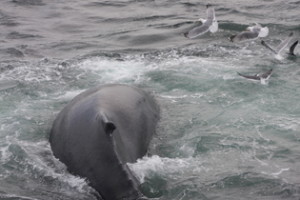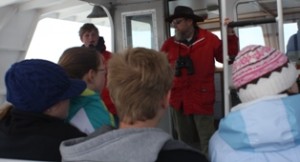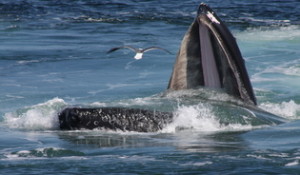Dolphin Fleet Naturalist Notebook – May 1-7

By afternoon the whales have moved offshore and sightings include a Minke, fin, 4 humpback whales and a large pod of dolphins. The whales were less active than in the morning, one humpback was resting, a behavior called ‘logging’ and the other approached the Dolphin VIII and circled around the boat. The dolphins were swimming with the humpback whales and were a good indicator of where the larger whales would surface. By sunset even fewer whales were in the Triangle. Even with excellent visibility we could not find the whales we had been watching earlier in the day. We sighted 2 humpbacks and 1 fleeting view of a finback whale. Our first day far offshore ended with a beautiful sunset.
May 2 was hazy and warm with light southwesterly winds. In the morning we traveled back to the Triangle and sighted 6 humpback whales. We were able to identify Monarch, born in 1998 to Dome, Tapioca, sighted first in 2004, and Northstar, sighted first in 2008. The whales were moving around the area and occasionally lifted their tails. On our way back to Provincetown, The Calvineers, a group of 7th and 8th grade students from Adams School in Maine, are on a mission to bring awareness to issues that threaten the survival of right whales and educate the public about their namesake, Calvin and the resiliency of nature to endure despite human threats. Calvin, a female right whale, was forced to face the world on her own after her mother died while she was still a young calf. Amazingly, Calvin not only survived, but went on to birth two calves, demonstrating great determination to live while contributing to a population on the brink of extinction. Google this incredible group for more information! During the afternoon the Portuguese Princess sighted 7 humpbacks and 1 finback whale. Most of the humpbacks, with the exception of Fulcrum appeared to be juveniles. Fulcrum is a mature female born in 1997 to Chimney who was born to Ebony. She has returned with 2, 4th generation calves! A small humpback named Broomball was kick feeding. The DVIII ventured into the same area as well and saw 10 humpbacks and 2 Minke whales. Only 2 whales were identified: Fulcrum and a second mature female named Springboard. Springboard was sighted first in 1997 and has returned with 2 calves. Both large females were kick feeding, eventually coming to the surface with mouths wide open!

May 3 was overcast with cool Northwesterly winds. Once again we ventured towards the Triangle where we sighted several humpback whales (20-30 in the area!), 3 finback whales and over 200 Atlantic white-sided dolphins.

Most of the whales were surface feeding- some kick feeding. We identified Shark, Pisces, Aswan, Wizard and Abrasion. Aswan, born in 2000 to Nile, was the only male identified. The others are all mature females who have returned with calves: Abrasion-1, Pisces- 5, Shark- 9, and Wizard-5. The dolphins also appeared to be feeding in the area. If we were to deploy hydrophones, we ccould listen to the amazing sounds made by the dolphins. This underwater microphone picks up a series ofl sounds- clicks, chirps and whistles.. While the chirps and whistles may be more social or communicative in nature, the clicks are part of the dolphins echolocation system- built in sonar that allows them to “see” their world through sound. We learn that sound travels about one mile (1500 meters) per second in the water-faster than in air. It is believed that dolphins send out a series of clicks and can determine the distance to a target by measuring the time between the emitted click and the returning echo. The echo is the returning sound bouncing off the target, perhaps a school of fish. Amazingly, the time it takes a click to travel to a school of fish 100 meters away and bounce back to the dolphin is about 1/8 of a second!
May 4 was bright with calm seas. Our first sighting was of seals, both gray and harbor near Long Point. We ventured far from Race Point to an area southeast of the triangle. There we sighted over 24 humpback whales and over 600 dolphins. We identified Perseid, a mature female, with her 2nd calf. Perseid was born to Palette who was born to Compass. This calf is a fourth generation! Mira, Samovar, Mars, Deuce, Soot and Ventisca were feeding. Some were kick feeding while others only blew a cloud or ring of bubbles surfacing with open mouths or lunging across the surface. By afternoon the whales had moved a bit closer. Although we saw only a small pod of dolphins, there were over 20 humpback whales widely spread about the area. Scylla’s calf of 2008 approached the boat, circling and swimming under from side to side for over 30 minutes. It was a great opportunity to see an entire whale and how effortlessly they can maneuver. Pinpoint, born to Horizon in 2004, was kick feeding as was Nazka and Greenbean. Nearby, a feeding finback whale lunged across the surface. All in all, a spectacular afternoon.

May 5 was sunny and calm with excellent visibility. We traveled far to the southeast where we sighted 5 species of cetaceans: humpback, fin and Minke whales, white-sided dolphins and harbor porpoise. Several small groups of dolphins were in the area totaling over 400 individuals. They are the most common toothed whale in the waters off Cape Cod. Toothed whales, with the exception of the sperm whale, are generally smaller than baleen whales, have teeth of varying number and shapes, and one nostril called a blowhole on top of their head. Toothed whales use their teeth to grasp onto their prey before swallowing them whole. They are group or family oriented. These groups called pods, schools or gams are often comprised of family members that swim, feed, rest and socialize together. Our views of the finback and Minke were fleeting but we saw a variety of humpback whale behavior ranging from logging (resting) to kick feeding. We identified: Aerospace, first sighted in 2007; Cosmos, born to Colombia in 1997; Measels, first sighted in 2002; Nazka, a female first sighted in 2002; Putter, a male born to Mars in 1993; Xylem, first sighted in 2003 and Zepplin, Pisces, Ganesh and Ventisca, all mature females who have returned with calves.
May 6 was overcast with southwesterly winds. Once again we traveled east where we had several sightings during the week, but few birds and fewer whales were sighted. Even with extensive tracks to the North and south, we found only 1 humpback whale and a small pod of harbor porpoise. The humpback was small, most likely only a few years old and not a whale that we knew.
May 7 was bright with cool Northwesterly winds. The DVIII ventured to the southeast where whales were sighted the evening before. Despite excellent visibility, there were no whales or birds in sight. Finally, after a long search, we found 3 humpback whales and one finback. Two of the humpback whales, Sword and Nimbus, were well known to our naturalist. Sword is a male, born to Janus in 1984 and Nimbus a mature female first sighted in 1984, Nimbus has returned to the waters off Cape Cod with 5 calves. With the exception of Sword’s tail breaches (a tail-fist leap out of the water), the humpbacks were moving steadily to the southeast. The Portuguese Princess explored a different area and traveled North across Stellwagen Bank through the Stellwagen Bank National Marine Sanctuary. Virtually the size of the state of Rhode Island, the sanctuary includes the submerged lands of Stellwagen Bank, all of Tillie’s Bank and Basin, and the southern portions of Jeffrey’s Ledge. It rises up from depths of 600’, leveling off at an average of 100’below the water’s surface. The Stellwagen Bank National Marine Sanctuary protects 842-square-miles of open water and the diverse seafloor beneath, created some 14,000 years ago during the retreat of the last Great Ice Age.
Today, we find 8 humpback whales mid-way on the Bank. Our first sighting was of a mother and calf.

The mom, Flamingo, was kick feeding and the young calf, most likely still nursing, was diving into the froth of bubbles- perhaps learning how to feed. Also feeding nearby were Falcon, Vulture and Monarch and a mature female named Scratch. The DVIII returned to the bank in the afternoon and more humpback whales, between 15- 18, were sighted as well as a small pod of dolphins. Most of the whales were kick feeding or lunging across the surface. In the mix were three mothers and calves: Loon, first sighted in 1985 with her sixth calf, Perseid, born to Palette in 1998 with her second and Cajun, born to Cascade in 1998 with her second. Perseid’s and Cajun’s calves are fourth generation! Also identified were Bramble, Meerkat, Whirligig, Nazka, Blackhole, Cygnus and Reflection. All in all a spectacular week of whale watching.






